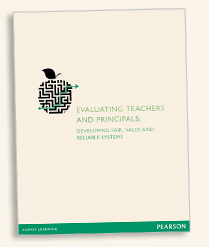Pearson Launches New Guide to Strengthen Teacher/Principal Performance

News release: “Strengthening Teacher and Principal Performance: New Guide Offers Best Practices to States and Districts”
BLOOMINGTON, Minn.– Improving educator effectiveness is a large component of every current, major state and federal education initiative. In fact, the Education Commission of the States reports that 19 states have revamped their teacher evaluation systems in the past year–and many others are currently debating changes. These changes are also the result of federal programs, such as Race to the Top, the reauthorization of the Elementary and Secondary Education Act, and the Teacher Incentive Fund grants.
This guide aims to help policymakers, state board members, school district leaders, and other stakeholders as they design educator effectiveness systems that are fair, valid, and legally defensible.
“Moving to new ways of thinking about teacher evaluation and career development for educators requires transforming the cultures of schools and districts around the country. For this to occur, stakeholders at all levels, from parents to representatives of teachers to governmental officials, must be a part of the discussion,” said Cynthia G. Brown, Vice President for Education Policy at the Center for American Progress. “Pearson’s new guide is intended to help build successful educator effectiveness systems and serve as a platform to foster a healthy national dialogue about the process, its challenges, and opportunities.”
Pearson’s guide walks education leaders through numerous steps necessary to engage stakeholders effectively and build a strong policy framework for educator effectiveness systems. Steps include:
- Defining the construct for what constitutes an effective educator
- Deploying multiple indicators to reveal evidence that characterizes good teaching and school leadership
- Building strong data analysis and reporting tools to reveal useful information about students, educators, and schools, including how they perform and how they can continually improve through targeted feedback and ongoing professional development
“Next-generation educator effectiveness systems need to be designed so they fairly evaluate educators, continually build educator capacity, provide ongoing career development and, ultimately, improve learning outcomes for all students,” said Kelly Burling, Ph.D., Director of Pearson’s Center for Educator Effectiveness. “A key goal of our new guide is to help leaders establish reasonable parameters for educator effectiveness systems, and then engage stakeholders in the development and implementation of their key features. The guide can help leaders position their initiatives in a manner that illuminates the value of educator effectiveness systems to a variety of audiences.”
Developing fair and valid educator effectiveness systems is a focus of Pearson’s research and development agenda, which builds on years of experience working with states and national organizations, such as the National Board for Professional Teaching Standards (NBPTS) to develop, deliver and score pre- and in-service educator assessments, teacher and leader rubrics, and evaluator training protocols.
“As states and school districts transition to new educator effectiveness systems, Pearson stands ready to share our technical expertise and to help policymakers and practitioners learn from each other,” continued Dr. Burling. “We’re working with research and business partners to create resources such as this guide, as well as additional research papers on timely topics, a publicly accessible web portal, regional workshops, and webinars, to give states and districts the resources they need to establish quality evaluation systems.”
In addition, Pearson invites education leaders to share their insights on the content of the guide as well as perspectives on the components of a successful educator effectiveness system at http://educatoreffectiveness.pearsonassessments.com/guide.
“By sharing experiences in this open online environment, states and school districts will learn from one another as we all work together to launch the next generation of educator effectiveness systems,” said Dr. Burling.
This new guide as well as other tools and resources for improving educator effectiveness, including information about a workshop on the new guide slated for this spring in Washington, D.C., will be available on Pearson’s Educator Effectiveness website at http://educatoreffectiveness.pearsonassessments.com or by contacting Abigail Rogers at[email protected].





0 Comments
Leave a Comment
Your email address will not be published. All fields are required.